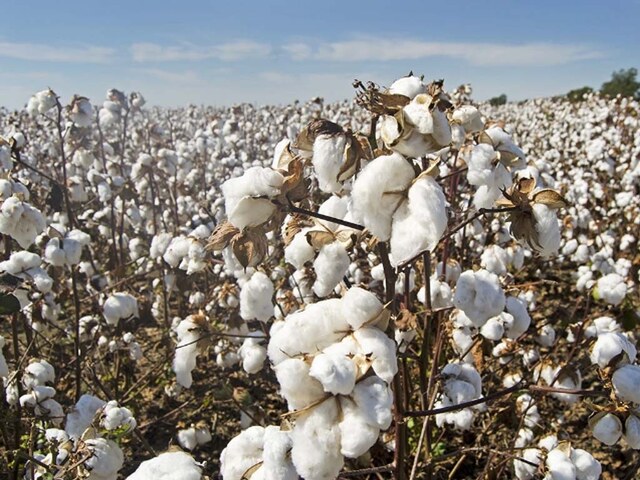By Naseem Usman
Copyright brecorder

KARACHI: The domestic cotton market is experiencing a bearish trend, with spot rate declining by a significant Rs 500. This reduction in cotton prices has raised concerns among farmers and the textile industry.
Kamran Arshad, Chairman of the All Pakistan Textile Mills Association (APTMA), stated that due to low domestic cotton production, the country will need to import 7.5 to 8 million bales in the coming period. This situation will place additional burden on the country’s foreign exchange reserves.
According to a recent report by the Pakistan Central Cotton Committee (PCCC), cotton production is expected to increase by 40 percent. However, Head Transfer of Technology Central Cotton Research Institute Multan Sajid Mahmood has warned that floods, heavy rains, and heat waves pose serious threats to overall production.
Cotton farmers are experiencing severe anxiety as cotton prices have dropped considerably. Farmers report that agricultural input costs remain high while crop prices are very low, deteriorating their economic condition.
The merger process between the Pakistan Central Cotton Committee (PCCC) and the Pakistan Agricultural Research Council (PARC) is facing delays. These delays are having serious negative impacts on cotton production and research infrastructure.
The Pakistan Business Forum (PBF) has proposed deferring the 18 percent sales tax for the next two years to provide relief to cotton farmers and revive the industry.
Recent statistics show that the country’s textile exports have recorded a 7.3 percent decline, negatively affecting the nation’s overall export performance.
The local cotton market experienced a bearish trend during the past week, with prices continuing to face downward pressure. Flood-affected and rain-damaged cotton is currently trading between 14,800 to 15,200 rupees per maund, while good quality cotton prices range from 15,300 to 16,000 rupees per maund, depending on quality and payment conditions.
Reports indicate that destructive rains and flooding have severely damaged cotton crops, particularly in several districts of Punjab province. However, accurate damage assessments can only be conducted after floodwaters recede completely.
The Pakistan Business Forum has submitted crucial recommendations to Finance Minister Muhammad Aurangzeb through a formal letter, proposing recovery measures for the country’s flood-affected agricultural sector. The forum has specifically recommended deferring the 18 percent sales tax on cotton for the next two years to provide relief to cotton farmers during the rehabilitation period.
Cotton farmers are experiencing significant anxiety as input costs remain high while market prices have dropped substantially, creating a challenging economic environment for agricultural producers.
According to the Pakistan Cotton Ginners Association (PCGA) report, cotton arrivals across the country reached 2,004,384 bales by September 15, 2025, representing approximately 40 percent increase compared to 1,434,028 bales during the same period last year. This translates to a notable increase of 668,752 bales in cotton arrivals for the current year through September.
Punjab province has received 690,254 bales so far, marking a 28 percent increase compared to last year’s 538,686 bales during the corresponding period. Sindh province recorded cotton arrivals of 1,314,130 bales, demonstrating a 47 percent increase over the previous year. Balochistan also showed positive trends with 75,100 bales recorded for the current year.
Nationwide, 1,652,204 bales have been supplied to textile mills, while current stock levels stand at 325,780 bales, comprising 97,712 bales in press stock and 228,068 bales in phutti form. Additionally, 428 ginning factories remain operational across the country.
The contrasting situation of increased production alongside market price decline reflects the complex challenges facing Pakistan’s cotton sector as it navigates both natural disasters and market dynamics.
Chairman of the All Pakistan Textile Mills Association (APTMA), Mian Kamran Arshad, has announced that Pakistan will produce only 4.5 million cotton bales during the current season, representing a decrease of 2 to 2.5 million cotton bales compared to previous production levels.
The textile sector will need to import 7 to 8 million bales worth over 3 billion dollars to meet its requirements. Following this statement from the APTMA Chairman, cotton prices in Pakistan have shown a significant increase.
In Sindh province, cotton prices range from 14,800 to 15,800 rupees per maund depending on quality and payment conditions, while Phutti prices are trading between 6,500 to 7,200 rupees per 40 kilograms.
The rate of cotton in Punjab province is in between 14,800 to 16,000 rupees per maund, with Phutti prices ranging from 6,000 to 7,900 rupees per 40 kg. In Balochistan province, cotton is priced at 15,600 to 15,900 rupees per maund, while the rate of Phutti is in between Rs 6,600 to 7,200 rupees, while the rate of Balochi Phutti is in between 8,200 to 8,400 rupees per 40 kg.
The Karachi Cotton Association’s Spot Rate Committee reduced the spot rate by 500 rupees per maund, closing at 15,300 rupees. Naseem Usman, Chairman of the Karachi Cotton Brokers Forum, reported that international cotton market prices showed improvement, with New York cotton futures trading between 67.00 to 69.00 American cents per pound.
According to the USDA’s weekly export and sales report, 186,100 bales were sold for the 2025-26 season. Vietnam led the purchases with 77,700 bales, followed by India with 41,800 bales in second position. Malaysia ranked third with 22,000 bales, Turkey fourth with 17,300 bales, and Pakistan fifth with 6,400 bales purchased.
For the 2026-27 season, 19,000 bales were sold, all of which were purchased by Vietnam.
Pakistan’s cotton industry, considered the backbone of the country’s economy, stands at an uncertain crossroads today. On one hand, the latest report from the Pakistan Cotton Ginners Association (PCGA) brings encouraging news of a significant increase, showing that cotton arrivals have risen by approximately 40 percent compared to last year as of September 15, 2025. However, on the other hand, natural disasters including heavy rainfall, floods, heat waves, and the cotton leaf curl virus are sounding alarm bells for a decline in overall national production.
This presents a scenario where the recorded increase may provide temporary relief, but policy crises, agricultural challenges, and industry negligence have put the entire value chain from farmers to textile manufacturers through a major test. The cotton sector, which has long served as the economic backbone of Pakistan, now faces multiple pressures that threaten its stability and future growth prospects.
While the 40 percent surge in cotton arrivals offers hope for the industry, the underlying challenges including climate-related disasters and viral infections in crops paint a more complex picture. The Pakistan Cotton Ginners Association’s figures highlight the resilience of the sector, yet experts warn that sustainable growth requires addressing the fundamental issues affecting production across the agricultural landscape.
The current situation reflects broader concerns about Pakistan’s agricultural policy framework and the need for comprehensive strategies to support cotton farmers while ensuring the textile industry’s competitiveness in global markets.
Head Transfer of Technology Department Central Cotton Research Institute Multan Sajid Mahmood said cotton, long regarded as the backbone of Pakistan’s economy, today stands at a critical crossroads. On one hand, the latest report of the Pakistan Cotton Ginners Association (PCGA) offers encouraging news, showing that by September 15, 2025, cotton arrivals had increased by nearly 40 percent compared to last year. On the other hand, torrential rains, floods, heat waves and Cotton Leaf Curl Virus are sounding alarm bells of a decline in overall national production. While the recorded increase provides temporary relief, policy failures, agricultural challenges and industry indifference have pushed the entire value chain from farmers to the textile sector into a severe test.
According to the report released today by the Pakistan Cotton Ginners Association, total cotton arrivals across the country reached 2,004,384 bales by September 15, 2025 compared to 1,434,028 bales during the same period last year, marking an increase of 40 percent. This reflects a rise of 668,752 bales so far this season. In Punjab, 690,254 bales have arrived compared to 538,686 bales last year, an increase of 28 percent, while Sindh registered 1,314,130 bales, a rise of 47 percent over the previous year. Balochistan also displayed a positive trend, with 75,100 bales recorded this year. Overall, 1,652,204 bales have already been supplied to textile mills nationwide. At present, a stock of 325,780 bales remains, including 97,712 pressed stock and 228,068 seed cotton. Meanwhile, 428 ginning factories are operational across the country.
However, estimates suggest that due to floods and recent heavy rains, production could decline by 0.6 to 1 million bales, plunging the country’s largest agro-industrial chain into uncertainty. In South Punjab, particularly Jalalpur Pirwala, Alipur and Lodhran, cotton crops suffered massive destruction due to flooding. Similarly, in Bahawalnagar, rainfall caused extensive damage, with around 40 percent of the crop destroyed in tehsils such as Fort Abbas, Minchinabad, Chishtian and Haroonabad. This loss has directly impacted both farmers and the ginning industry, as the shortage of raw material has limited operations. The consequences have now rippled through the textile value chain, where rising costs and disrupted production are threatening yarn, fabric and garment stages. Nationally, production is feared to fall to only 5 million bales, compelling Pakistan to import over 6 million bales to meet domestic demand. This trend will not only strain precious foreign exchange reserves but also worsen the trade deficit and economic pressure.
In comparison, Sindh has shown relatively better performance than Punjab this season in terms of both yield and quality. While pest attacks remained limited in both provinces, Cotton Leaf Curl Virus exacerbated crop losses. The combined impact of excessive rains, floods, diseases and heat waves has severely undermined production. Moreover, the destruction of crops has raised another pressing concern: seed availability for the next season, further deepening the uncertainty for future cultivation.
Copyright Business Recorder, 2025



